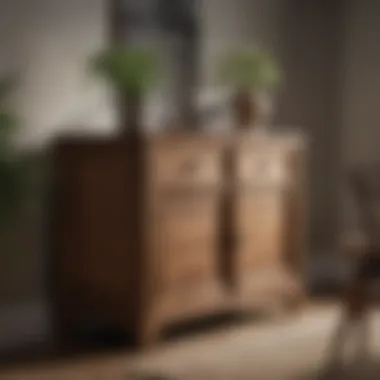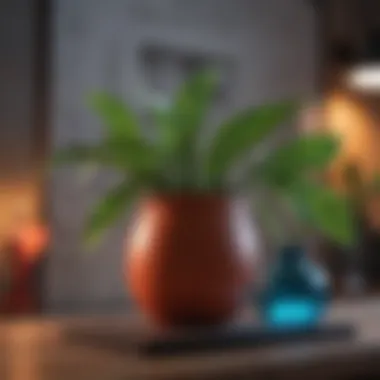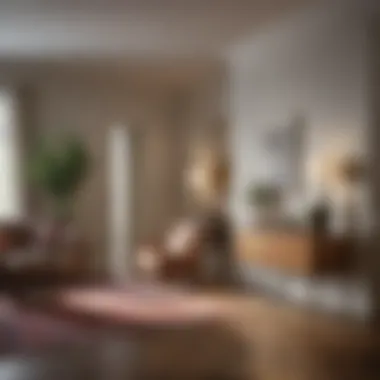Budget-Friendly Home Decoration Ideas


Intro
Decorating one’s home should not be a privilege reserved for those with deep wallets. In fact, a well-curated living space can come from a blend of creativity, ingenuity, and a touch of resourcefulness. This guide aims to explore economical aesthetics that bring the exemplary charm of decor into any household without breaking the bank.
We will delve into unique decoration strategies ranging from repurposing forgotten furniture to integrating elements from nature. By the end of this journey, you'll not only gain insights into practical applications for your living environment but also discover how to craft an atmosphere that feels harmonious and sophisticated, even on a shoestring budget.
Design Inspiration
Current Interior Design Trends
Modern decor trends seem to draw heavily from personal stories and environmental consciousness. Instead of opting for mass-produced items, today's homeowners are increasingly turning to originality. Vintage and thrifted finds have come to the forefront. It’s not uncommon to spot mid-century chairs or rustic handmade tables that tell their own tales.
People are also leaning towards sustainability. Materials like bamboo not only add a stylish touch but also promote eco-friendliness. This trend encourages individuals to play with traditional materials, employ upcycling, and add their unique flair through thoughtful customization.
Color Palettes and Their Effects
Color plays a pivotal role in setting the mood of any room. Warm tones, such as burnt orange or deep reds, can urge an inviting atmosphere, whereas cooler shades like soft blues and greens are calming and can create a serene escape.
Using a limited palette can make a space look cohesive. For a budget-friendly approach, consider painting an accent wall instead of a complete renovation. Here are some notable palettes to consider:
- Earthy Tones: Deep browns, mossy greens, and muted terracottas evoke minimalism and rustic charm.
- Pastels: Soft yellows, pinks, and sky blues can make smaller spaces feel airy and cheerful.
- Monochrome: Shades of gray paired with black or white create elegance and simplicity.


Each palette will dramatically influence how the space feels and functions, so choose wisely.
"A well-designed home is a reflection of oneself, a blend of tradition and contemporary, seasoned with personal passions and stories."
Nailing down a polished look doesn’t necessitate a grand budget; rather, it speaks to the heart of being inventive and resourceful with what one already owns.
In the sections that follow, we'll uncover methods for making the most of your space, exploring ways to decorate creatively with genuine, heartfelt elements that resonate with anyone visiting your home.
Prelude to Budget-Friendly Home Decor
When we think about home decoration, the first thoughts may be lofty. Beautiful spaces often come hand in hand with large budgets, but that’s a myth that deserves to be debunked. Budget-friendly home decor isn't merely about reducing costs; it's about creativity, resourcefulness, and making decisions that enhance both the aesthetics and functionality of a space without breaking the bank.
Affordable design allows homeowners to express their individual styles while maintaining fiscal responsibility. It opens the door for innovative thinking that doesn't rely on high-priced materials or professional installation. Instead, it invites creative solutions that can transform even the most neglected areas of a home into stunning showcases, reflecting personality and taste.
Understanding the Importance of Affordable Design
Affordable design is not just a trend; it's a necessity for many today. In a world where finances can often feel tight, creating a beautiful living space shouldn't feel like a faraway dream. When you prioritize cost-effective strategies, you’re not merely saving money; you’re embracing a mindset of sustainability and practicality. Homeowners can explore countless ideas, from using thrift store finds to employing basic DIY techniques, which can altogether yield remarkable results.
Additionally, affordable decor encourages a deeper connection with your home. When you’ve invested time and creativity into your space, it leads to a sense of accomplishment that a simple buying spree often lacks. Moreover, it fosters a sense of community, especially if you choose to collaborate with local artisans or shop at local markets.
Setting a Realistic Budget for Decor


Setting a realistic budget is the backbone of any successful home decoration project. Start by evaluating your current financial situation: what amount can you allocate for decorating without feeling the pinch later? This goes beyond just the price tags of items; it's about considering all potential costs, including tools for DIY, paint, and even delivery fees.
- Create a budget plan: List categories such as furniture, wall decor, textiles, and plants. Allocate a specific amount for each category based on your priorities.
- Prioritize needs over wants: Focus first on essential items that improve your quality of living, then sprinkle in some fun decor as funds allow.
- Monitor expenses: Keeping track of how much you actually spend versus what you planned can reveal surprising insights about where you can save more.
Lastly, don’t forget to factor in some flexibility in your budget. Some projects may go awry or require more materials than anticipated. Building in a small cushion can save you from unnecessary stress.
"A budget is not just a set of numbers, it’s a blueprint for your dreams."
Individuals who approach home decor with a budget-conscious perspective find themselves exploring new avenues for creativity while consciously shaping their living spaces. By embracing these practices, you accomplish far more than mere aesthetic improvements. You cultivate a home that tells a story, resonating warmth, care, and thoughtful execution.
Reimagining Existing Furnishings
Reimagining existing furnishings serves as a cornerstone in the world of economical aesthetics. Many homeowners often overlook the treasure trove of potential right under their noses—old, sometimes outdated pieces that can find new life through creativity and ingenuity. In an era where sustainability intertwines with style, focusing on reworking these items can bring forth several benefits. Not only does this approach reduce waste and promote eco-friendliness, but it also allows for a personalized touch that mass-produced furniture simply cannot provide.
The act of giving new life to your old furnishings presents a practical solution to decorating challenges. By tapping into the charm of your current items, you can cultivate a unique style that reflects your personality and taste without breaking the bank. It’s also worth noting that reimagining furniture is often less time-consuming and more rewarding than starting from scratch. A little effort can go a long way to elevate the space.
In this journey of creativity, let’s look into specific strategies that can breathe new life into forgotten or neglected items.
The Art of Upcycling
Upcycling is not just a buzzword; it's an essential aspect of modern decor that embraces creativity, sustainability, and resourcefulness. Taking the time to transform something old into a fresh piece can add character to your home. For instance, an old wooden ladder can be reimagined as a charming bookshelf or a stylish plant stand. The process is simple, yet it requires a bit of imagination.


When embarking on upcycling, consider the materials at hand. Look around your living space; this might include wooden pallets, wine crates, or even old picture frames. Each item holds potential.
- Wood Pallets: Stacked and painted, they can become a cozy coffee table or a garden bench.
- Old Jars: These can be painted and transformed into beautiful candle holders or vases.
A key element of upcycling is that mistakes can often lead to unexpected artistic expressions. So, don't stress about achieving perfection—embracing the imperfections is part of the charm.
Refinishing Techniques for Old Furniture
Refinishing furniture stands as a practical, yet oft-overlooked solution for those with a knack for DIY projects. Instead of discarding that tired desk or table, explore the numerous refinishing options available. One of the simplest methods is sanding. This can eliminate scratches and old paint, revealing the original shine of the wood beneath. A fresh coat of paint or stain can provide a dramatic transformation.
Consider the following techniques:
- Paint: A bold color or vintage hue can completely alter its look. Chalk paint lends a matte finish, while high-gloss for a modern touch.
- Stain: Using a stain can enhance the wood grain, making pieces more visually appealing without being overpowering.
- Decoupage: Tacky or outdated furniture can beautifully transform through the use of wallpapers or art prints, allowing for personal expression.
With some patience and creativity, old furniture can become focal points in your home rather than simply functional items.
Creative Rearrangement of Space
Rearranging existing furnishings can feel like a refreshing breeze in an otherwise stagnant area. This practice goes beyond merely shifting items around; it involves thoughtful consideration of space usability and flow. Before you start, take a moment to evaluate how you interact with the space and what changes might enhance that experience.
Here are some ideas to get you started:
- Symmetry vs. Asymmetry: Play with balance. A symmetrical setup creates calmness, while an asymmetrical layout adds energy and whimsy.
- Zoning: Define specific areas for activities. A reading nook or a work space can be formed using furniture placement, allowing for functional diversity without the need to buy more.
- Negative Space: Leaving areas empty provides a that breathing room and can highlight specific pieces of decor.
Tip: Always experiment and be unafraid to shift furnishings multiple times. Sometimes the best arrangement is found accidentally!















